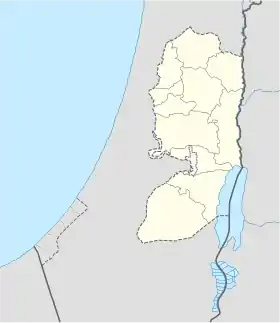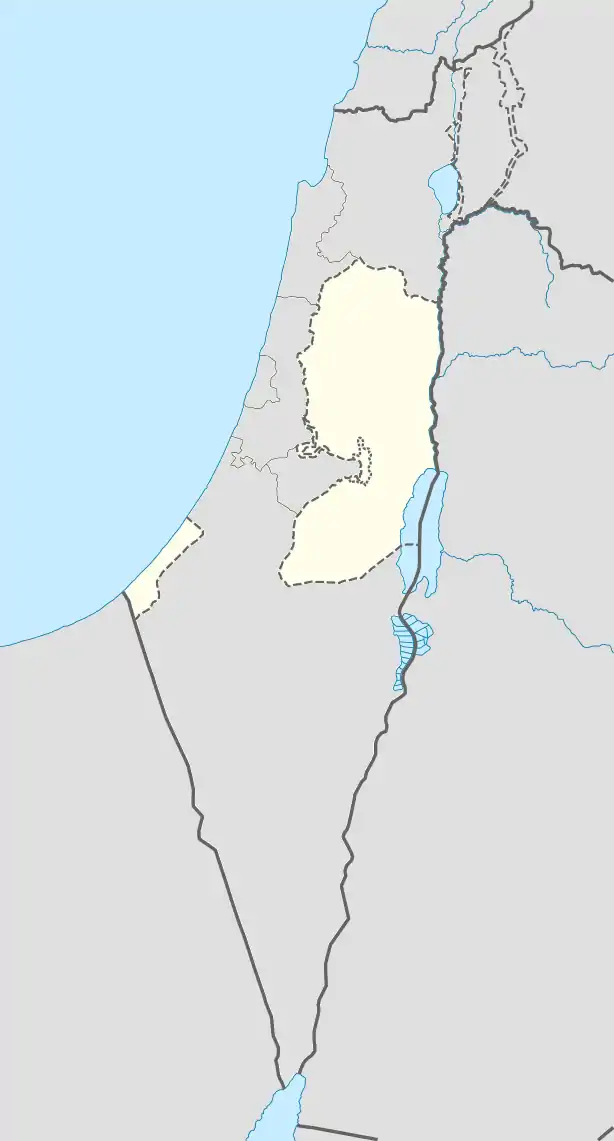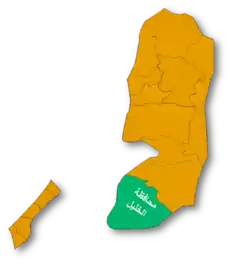Kuzibah | |
|---|---|
| Arabic transcription(s) | |
| • Arabic | كوزيبا |
| Coordinates: 31°36′1″N 35°09′25″E / 31.60028°N 35.15694°E | |
| Palestine grid | 164/112 |
| State | State of Palestine |
| Governorate | Hebron |
| Government | |
| • Type | Municipality |
| Population (2017)[1] | |
| • Total | 1,383 |
| Name meaning | the ruin of Kuzeiba, p.n., possibly from the Heb. Chozeba[2] |
Arabic: كوزيبا | |
| Alternative name | Kūzībah (ar) |
|---|---|
| Height | 872m |
| History | |
| Periods | Second Temple period |
Khirbet Kuwayzibah (Arabic: كوزيبا, Hebrew: ח'רבת כויזבה), also Kuzibah, Kueiziba, is an ancient ruin, partly inhabited, in the Hebron Governorate in the West Bank, presently part of Sa'ir. The modern Palestinian village had a population of 1,383 in 2017.[1]
Etymology
Edward Henry Palmer noted in 1881 that Khurbet Kueiziba could possibly be a modern derivation of the Hebrew placename Chozeba.[2]
History
The site is dated to classic antiquity, and usually identified with Chozeba, also Kuseva (Hebrew: כוסבה) - the place of origin of Simon Bar Kokhba.[3][4] At the foot of the ruin are several springs, known as 'Ain Kueiziba, along which are the remains of ancient pools. These springs are the source of water for the Arrub aqueduct, which together with other aqueduct supplied the water to the Roman aqueduct to Jerusalem.[5]
In 2009, several residents of Kuwayzibah were interviewed for a Channel 1 article about Tzvi Misinai and admitted they are of Jewish descent.[6]
See also
References
- 1 2 Preliminary Results of the Population, Housing and Establishments Census, 2017 (PDF). Palestinian Central Bureau of Statistics (PCBS) (Report). State of Palestine. February 2018. pp. 64–82. Retrieved 2023-10-24.
- 1 2 Palmer, 1881, p. 400
- ↑ Conder, Claude R. Tent Work in Palestine: A Record of Discovery and Adventure (1887 ed.). p. 143.
- ↑ Suxeríuse, Khirbat Kuwayzibah. Aharon Oppenheimer (1997). "Leadership and Messianism in the Time of the Mishnah". In Henning Graf Reventlow (ed.). Eschatology in the Bible and in Jewish and Christian Tradition. A&C Black. p. 162. ISBN 978-1-85075-664-4.
- ↑ Masterman, E. W. G. (1902). "The Water Supply of Jerusalem, Ancient and Modern". The Biblical World. 19 (2): 87–112. doi:10.1086/472951. ISSN 0190-3578.
One of these sources takes its rise in a small pool, the Birket Ktfin; the other starts from the 'Ain Kueiziba. The channels from these two sources converge and join their waters in the Birket 'Arrzib; at present this is quite a ruin, but it is evident that originally it was similar to the highest of the three Pools of Solomon. From this Birket the water passed to the long and extremely tortuous aqueduct which runs twenty-eight miles 32 to the Pools. Originally this aqueduct entered the second pool, but now the water descends by a rough, steep channel to the lowest pool
- ↑ "The Jewish Origins of Palestinians", Channel 1 (Israel) (News Report), 11:50, 2009, retrieved 2022-02-23
Bibliography
- Conder, C.R.; Kitchener, H.H. (1883). The Survey of Western Palestine: Memoirs of the Topography, Orography, Hydrography, and Archaeology. Vol. 3. London: Committee of the Palestine Exploration Fund. (pp. 312-313, 358)
- Palmer, E.H. (1881). The Survey of Western Palestine: Arabic and English Name Lists Collected During the Survey by Lieutenants Conder and Kitchener, R. E. Transliterated and Explained by E.H. Palmer. Committee of the Palestine Exploration Fund.
External links
- Welcome To Kh. Kuweiziba
- Survey of Western Palestine, Map 21: IAA, Wikimedia commons


